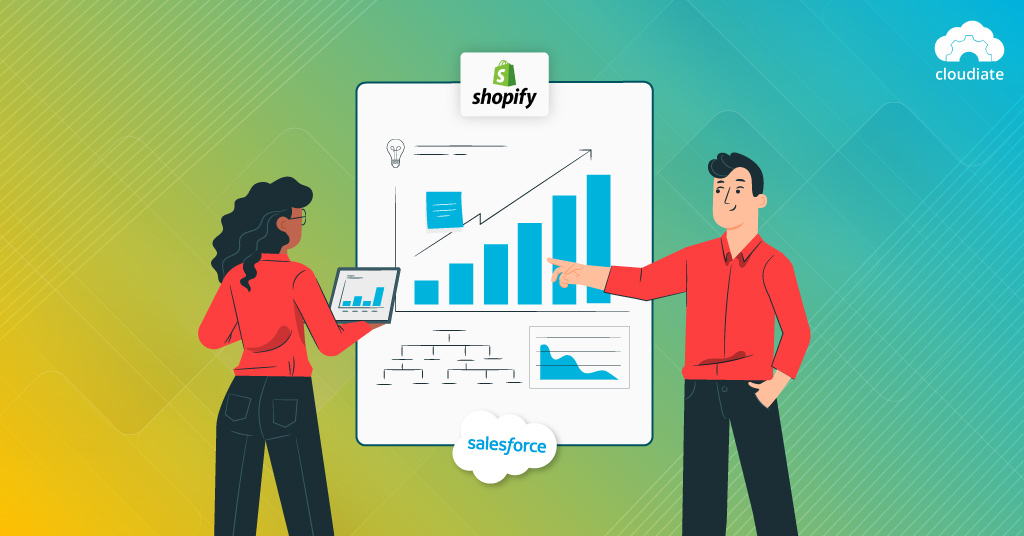When setting up your e-commerce business, efficiently managing customer data is crucial. With Shopify Salesforce integration, you will set yourself up for success and gain a competitive edge in the market.
The connection between the two softwares will help you enhance the features of both the CRM and the e-commerce platform.
This article covers the benefits of integrating Shopify with Salesforce, and the methods for implementing this integration.
Benefits of Shopify Salesforce Integration

When you start a Shopify e-commerce store, you will gather critical information such as the number of orders, customer contact details, inventory, etc. As your business grows, the amount of data will also increase. Therefore, you will need a CRM software like Salesforce to manage the mounting data.
With Shopify Salesforce integration, you will be able to manage your data better, generate sales reports, and create an accurate buyer persona using the tools offered by Salesforce.
Now, let’s understand the benefits in more detail.
1. Improve Marketing Operations
The integration will enable you to identify well-performing marketing campaigns to double down on them. Conversely, you can pause campaigns that are not bringing good results.
2. Aids Financial Planning and Analysis
The integration provides real-time and reliable data about transactions.
Upon analyzing the data, you can identify best-selling goods and forecast profit margins.
3. Retarget Existing Customers
Salesforce comes with handy tools that help you segment customers based on engagement levels. With this information, you can re-engage existing customers to buy again.
4. Business Intelligence Insights to Scale Your Business
To grow your e-commerce store, you need to lead with data rather than guesswork. The analytics tool of Salesforce provides insights into sales growth, customer engagement level, purchase history, etc.
The insights from Salesforce will help identify loopholes in your strategy so that they can be tweaked accordingly.
Let’s look at some methods for setting up Shopify Salesforce integration:
Methods of Integrating Shopify with Salesforce

Use Shopify and Salesforce Data Import Wizard
You can export customer data from Shopify and add it to Salesforce using the Shopify and Salesforce wizard. Let’s see how it’s done:
1. Log into your Shopify account. Go to the “Customer’s” tab and click “Export”.
2. Select the customers you want to add to your Salesforce account and click “Plain CSV”.
3. When you export customers from Shopify, it will create a CSV account that you can download.
4. Now, log in to Salesforce and look for the “Data Import Wizard” option. You can use the search menu to find the wizard quickly.
5. A screen will pop up with several options. Select the CSV file option.
6. The file fields are automatically mapped to Salesforce fields, but you can edit the mapped fields.
7. Click “Next”, and your data will be exported to Salesforce.
Merits
- This method works well when the amount of data is less.
Demerits
- The Salesforce Wizard cannot import more than 50,000 rows. Hence, if you have a large amount of data, then this method won’t work.
- It doesn’t allow you to change data before exporting it to Salesforce.
Use Shopify and Salesforce Bulk APIs
Salesforce Bulk API can be used to add data from external sources. An API is a software used to aid communication between two programs. Let’s understand how this method works:
1. To use this method, you need to generate an API username and password. Note the API key and password from the API section of the Shopify Admin console.
2. Use the following CURL command to view the list of customers.
curl –user:password GET https://shop.myshopify.com/admin/api/2020-07/customers.json >> shopify_customer.json
3. Use the following command-line JSON processor to create the JSON into a CSV.
cat shopify_customer.json | jq ‘.customers[] | [.id,.first_name,.last_name,.email,”Mr”,”Title”] | @csv’ >> shopify_customers.csv
4. Now, use the Salesforce Bulk API to load the data. Use the following file to start the sequence and name it “login.txt”.
<?xml version=”1.0″ encoding=”utf-8″ ?>
<env:Envelope xmlns:xsd=”http://www.w3.org/2001/XMLSchema”
xmlns:xsi=”http://www.w3.org/2001/XMLSchema-instance”
xmlns:env=”http://schemas.xmlsoap.org/soap/envelope/”>
<env:Body>
<n1:login xmlns:n1=”urn:partner.soap.sforce.com”>
<n1:username>salesforce_username</n1:username>
<n1:password>salesforce_password</n1:password>
</n1:login>
</env:Body>
</env:Envelope>
5. Use the configuration file mentioned above to log in. Save the session-id from the response of this command for future reference.
6. Now, initiate the Bulk API using the configuration file mentioned below. Name the file as “job.txt”.
curl https://instance.Salesforce.com/services/async/47.0/job -H “X-SFDC-Session: sessionId” -H “Content-Type: application/xml; charset=UTF-8” -d @job.txt
7. When you initiate the Bulk API, a job-id will appear. Save it for future reference.
8. Add the following data to the above job through the CSV file created in step.3
curl https://instance.salesforce.com/services/async/47.0/job/jobId/batch -H “X-SFDC-Session: sessionId” -H “Content-Type: text/csv; charset=UTF-8” –data-binary @shopify_customers.csv
9. Use the following CURL command to check whether the job has been completed or not.
curl https://instance.salesforce.com/services/async/47.0/job/jobId/batch -H “X-SFDC-Session: sessionId”
If the job shows “Completed”, then check Salesforce to see if the data has been loaded.
Merits
- The process can be automated since it uses APIs.
Demerits
- It cannot handle duplicated data.
- The above method only exports data from the first page since Shopify API is paginated. Additional logic must be applied to export data on the rest of the pages.
- To schedule recurring load, additional logic needs to be applied.
- The above approach can’t handle the transformation of data before loading.
- The Salesforce Bulk API has several limitations, such as usage, processing time, batch content, and lifespan limit.
Shopify Salesforce Integration with Cloudiate Consultants
With so many e-commerce businesses emerging, you must stand out from your competitors from the get-go. For that, you need the right tools.
Shopify Salesforce integration will be game-changing for your business, reducing your workload, and giving you customer insights to drive better decision-making.
To implement the integration, you can use the methods outlined above. But, if you want to avoid the limitations of Salesforce Shopify API and Wizard, get in touch with Cloudiate Consultants.
We are a registered Salesforce Implementation Partner offering world-class integration services while meeting your specific requirements.

